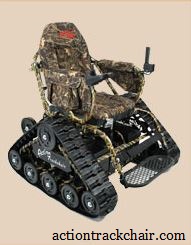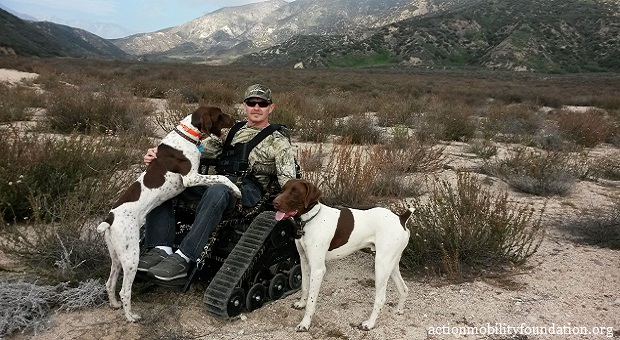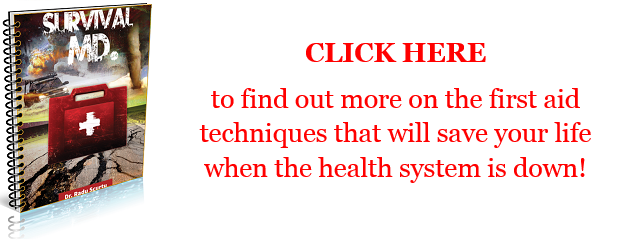When you don’t have the full use of your arms, legs, hands, or feet, getting through rough terrain seems impossible.
But you still might have to do it, and go through flooded streets, woods without nature trails, or other places that you would normally avoid because of your limited range of motion.
Don’t give up! There are devices that may be useful in a major crisis. In fact, even if you aren’t disabled, these methods and devices may help you one day, so you’d better keep some in your stockpile.
Keep reading to discover them!
How to Get Down a Hill With Foot, Knee, or Leg Impairments
If you have ever sprained an ankle or injured a knee, then you know that the pain and limitations in mobility can last for several weeks.
If you never gave disabilities a thought, then you will have a harder time dealing with a leg or knee injury. In particular, getting down a hill or other decline may seem impossible if you don’t have a full range of motion.
Doctors won’t be there to save you! This guide will tell you what to do instead!
Here are a few solutions for getting down safely and reduce the risk of increasing the injury even more:
- If you sprained your ankle within a few hours of approaching the hill, you will need to put a temporary support on it. You can make one from duct tape as well as other wrappings. Just make sure you wrap your ankle as loosely as possible.
- You can also make a knee brace using wrapping material, however you should practice this skill before trusting it on your knees in an actual situation. Purchase a good quality knee brace with velcro adjustments that will protect your knees and also reduce the risk of doing more harm because of incorrect wrapping.
- When going down a hill, many people make the mistake of either trying to go down face forward or backwards. Your best option is to stand sideways in relation to the decline and work you way across and then slowly downward. This will give you support with one leg without putting all your forward momentum on the foot that is moving down the hill. If you happen to land your foot on a loose rock or soil, this can save you from injury and also reduce the risk of making an existing injury even worse.
- Always use a walking stick to use as a brace for the leg, ankle, or foot that is injured. Practice walking with the staff, and also test it out on hills and rugged surfaces. It may feel a bit strange at first, but once you adapt your gait to the walking stick it will be much easier.
- A sturdy walking stick can help you move faster, and also makes a good weapon if you happen to need it. In fact, if you are alone and out in the wild, you can also sharpen on end of the walking stick to make a spear, or even attach knapped rock arrow heads. If you have a knife, you can also attach that to one end of the walking stick as a weapon or hunting tool.
How to Get Down a Hill if You Cannot Walk at All
If you are unable to walk at all, then you will need to sit down and inch your way down the hill, or you will need to lay down and roll slowly. Before making these efforts, try to immobilize the injured area and pad it as much as possible. Practice rolling or inching on flat ground first so that you can shore up any areas that need additional support and padding.
When immobilizing your legs, never tie them or bind them together. Even if both legs are injured or unable to move, tying them together can leave you at great risk. You are better off taking more time to pad each leg properly and then work slowly down the hill so that you jar your legs as little as possible.
If you have been using crutches, it would not be a good idea to try and get down the hill while standing upright. Even if you stand so that one side faces the decline, you will still be putting a lot of weight on the forward moving crutch, and may topple over more easily than expected.
Using Action Trackchairs: Pros and Cons
 More people are becoming wheelchair bound because of other medical conditions that don’t necessarily have to do with a physical injury. And if you have suffered a major illness or have undergone a surgery followed by a complex recovery period, you might also need a wheelchair temporarily.
More people are becoming wheelchair bound because of other medical conditions that don’t necessarily have to do with a physical injury. And if you have suffered a major illness or have undergone a surgery followed by a complex recovery period, you might also need a wheelchair temporarily.
As with so many other things, a large scale disaster isn’t going to wait for you to be strong enough to leave the wheelchair and travel as quickly and easily as you need. While most wheelchairs on the market work well enough in stores, at home, and on fairly flat surfaces, they are virtually useless on rugged trails or areas where terrain is rough.
The Actiontrack chair utilizes tracks (like a tank) instead of wheels like a conventional wheelchair. It can go in many places that would cause a conventional wheelchair to get stuck, or even tip over.
For example, the Actiontrack can be driven onto a beach, and can also go a small way into water.
As with tanks that rely on a track system, these chairs can be used off regular paths and on much rougher terrain than conventional wheelchairs. Since they are also motor powered, they are useful for people that have limited upper body strength or cannot otherwise push themselves along in a manual wheelchair.
Aside from helping you get from one place to another, some Actiontrack models will also support your weight if you need to stand up. These models are ideal if you intend to hunt, need to reach for vines, or have to carry out other tasks that cannot easily be accomplished from a seated position.
While there are many benefits to owning an Actiontrack chair, they can be very expensive. If you do not have an actual disability that requires this kind of device, then it doesn’t belong in your prepper budget.
On the other hand, given what this chair can help you do, it may prove useful as a bug out vehicle for cities or other areas where you still need to carry over 100 pounds worth of items and need to get through broken streets or other areas where walking may be difficult even for someone that has a full range of motion.
If you have a disability, cannot navigate easily, and can demonstrate financial need, the manufacturer of this mobility aide may be able to give you a reduction in cost. You will need to go to the site and fill out an application and see if help is available for you.
The Action Mobility Foundation may also have some other suggestions that will help you raise the money needed to buy one of these devices.
Tools and Supplies to Keep On Hand
Surprisingly enough, some of items you need to keep in hand in case of an issue that limits navigation aren’t expensive and can be used for other purposes. Here are the main items, as well as some others you might want to consider:
- Athletic cloth tape – can be used to stabilize joints as well as improvised devices made from items in nature. For example, if you need to make a crutch and don’t have any vines to bind the pieces together, you can use athletic tape to do the job.
- Popsicle sticks and slat boards – can be used to stabilize fractures in fingers and arms. They can also be used to immobilize joints that have been badly sprained so that you don’t injure them more.
- Knives, a small saw, and other cutting tools – you can use these to cut small boards to size, trim tree limbs, or carry out other tasks required for making mobility aides or repair them. These devices should already be part of your every day carry because they will be of use in many areas of survival. Even if you carry just a credit card sized EDC multi-tool it will be better than nothing.
- Pain reliever – you can choose from anti-inflammatory herbs as well as pain killers that will reduce swelling as the primary means of reducing pain.
- Disposable hot and cold packs – to use these packs, all you have to do is punch them to release heat or cause them to become cold. These are ideal for managing injuries that need cold or hot treatment in order to feel better, speed healing, or reduce the risk of injury.
- Towels – you can use towels for a wide range of mobility related needs including providing moist heat for an injury, wound management, and cleaning.
- Knee braces – they are especially useful if you already have older injuries, are overweight, or may develop a condition that will cause you to fall more easily as you age. While knee braces will not prevent a fall per se, they can help ensure your knees don’t get damaged even more.
- Back and abdominal support braces – these devices are very important for preventing hernias and other injuries associated with heavy lifting. During crisis, you may be doubling or even tripling the amount of physical activity you carry out in a single day, and you are also likely to be lifting, pulling, and pushing weights that are well beyond your usual comfort range, and there is always a risk of under-developing smaller muscles in gym workouts. You can easily develop muscle tears and other problems even if you lift weights and seem fine right now. Even a minor twist or turn in an unusual direction can spell trouble. Back and abdominal braces can reduce the impact of increased weight combined with motions you aren’t accustomed to.
- Folding cane – these canes are lightweight and can easily fit into any bug out bag. Choose one that you can easily adapt for a spear or knife, and you will also have a weapon, fishing pole, or other hunting aide. Aside from increasing mobility options, these devices are truly limitless in adaption options for survival needs.
- Rollating wheelchair – these chairs offer a combination for a wheelchair and a rolling walker. You can use them to sit down when you are tired, or for walking in areas where it is harder to get a wheelchair to move. These devices are also narrower than a conventional wheelchair, so they can also get into more areas. A rollating wheelchair has smaller wheels, and it can be a bit difficult to adjust to these chairs because they weigh less, which may make you feel like they aren’t as stable.
- Travois or similar – they can be used to carry items if you have a shoulder, neck, upper back, arm, or hand injury. You can customize the travois so that it has a harness that rests across your hips so that there is no weight on your shoulders or arms. If you do not want to carry collapsible poles that can be made into a travois, at last carry some rope that can be used to tie tree limbs together. Even if you never wind up dealing with a shoulder, upper back, neck, arm, or hand injury, you can still use this device to carry heavy objects. For example, if you catch deer, you can use a travois to haul the carcass to a safe location where you can finish processing it.
- Goggles and helmet – even though these are technically defined as safety devices, they are important for stabilizing and protecting mobility and range of motion. For example, a well constructed helmet can help protect your neck from injury as well as reduce the risk of a head injury if you fall or something lands on your head. Goggles are also very important for protecting your sight, especially if you need to work with tools or materials that can shatter or send harmful chemicals into your eyes.
- Fireproof and chemical proof gloves – both types are important, especially during the initial and post crisis stages. An accident that causes acid or lye to reach your hands can easily prevent you from carrying items and using your hands to carry out other survival tasks. No matter how much you practice with different tools, stress and unusual circumstances will still bring along risks you weren’t as prepared for as you thought you were. Appropriate gloves can limit damage in the first place, and protect existing injuries in situations where you have no choice but to use your hands.
Carrying Materials with Arm, Hand, or Shoulder Impairments
As with knee or ankle injuries, you can use splints and joint immobilizers to reduce further injury and give you at least some ability to move objects around.
If you have upper body, arm, shoulder, elbow, or hand injuries, you can also use ropes and lassos and then create a harness that falls across your hips.
Always try to limit lifting items as much as possible, and use your hands and arms for finer work such as tying knots or carrying out other tasks that will allow you to use your hips and legs for dragging objects along instead of carrying them.
No matter how carefully you prepare for disaster, you never know how your body will age, let alone if you will incur some injury that limits mobility.
While you may be focusing a good bit on doing this properly so that you reduce the risk of injury, it never hurts to have a backup plan. Having some additional tools and skills related to managing mobility issues can mean the difference between life and death.
Also, you should always be prepared to face a medical emergency that could reduce your mobility!
This article has been written by Carmela Tyrell for Survivopedia.






















































































Add a walking stick to your list and it will be about perfect. I can still walk with my disability but I often use a walking stick. Not a trekker pole, but a stick made of either vine maple or hazelnut (your location may vary), and as tall as I am. Especially for mushroom gathering. It’s length gives support climbing uphill and downhill. Plant the stick and use it like a handrail.